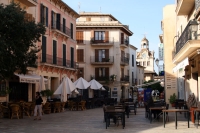
The ancient town of Alcudia, not to be confused with the popular modern resort two miles (3km) to its south, has a fascinating and turbulent history. The Phoenicians and Greeks settled here and the Romans made it their capital in the 2nd century BC. Destroyed by the Vandals in the 6th century it was rebuilt again by the Moors before being liberated by King Jaime I of Spain in the early 1200s. Today, visitors still enter the narrow streets of the old town through one of the two gates, which are guarded by large towers. There are lots of little cafes and a great market twice a week, on Sundays and Tuesdays, which brings the old town to life and attracts big crowds. The market is the perfect place to go souvenir shopping in the area. Near the town at Polentia there is a well preserved Roman amphitheatre and the Orator de Santa Anna, one of Mallorca's oldest churches. There are a couple of boutique hotels in Alcudia for those who want to spend some time in the charming medieval town.
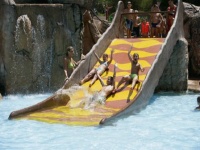
Aqualand is one place that is not to be missed by families on holiday in Mallorca. Children of all ages and parents alike will have a grand time splashing in the pools, riding the slides, floating on tubes, a mini water park for the little ones, or jumping in the wave pools. Those who don't relish excitement can enjoy the lazy river or the Jacuzzis, and the whole family will enjoy the surf beach and group rides. There are lockers and sun loungers available to rent for a small extra charge and there are various options for food and refreshments in the park. Benches and beach areas provide space for relaxation in between the thrills and spills. The park generally receives rave reviews from tourists and provides a fun day out for all age groups. There are discounts for booking online and having your ticket when you arrive allows you to skip any queues there may be at the entrance. Arriving early is also a good idea to get a jump on the crowds at this popular attraction.
Address : Palma, Arenal Motorway.
Website : www.aqualand.es
Telephone : +34 971 44 00 00
Opening times : Open mid-May to September: July and August from 10am to 6pm; May, June and September from 10am to 5pm.
Admission : €30 (adults); €21 (children aged 5 - 10); €12 (children aged 3 - 4). Family package deals available.
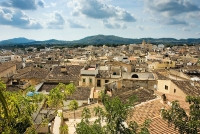
An ancient hilltop town close to the east coast of Mallorca, Arta has been occupied for about 3,000 years and today welcomes visitors to the remains of its Bronze Age settlement. The ruins of Ses Paisses are just outside the town in a grove of olive, carob, and holm oak trees, date back to about 1300 to 100 BC. Interesting archaeological artefacts can be viewed in the Regional Museum of Arta, while the Sanctuary of Sant Salvador provides picturesque views of the town with its bleached rooftops spilling down the hillside below Moorish battlements. The Baroque church was built in 1892 and is connected by a staircase of 180 steps to the parish church of Transfiguracio del Senyor at the foot of the hill, which is a Gothic structure built in 1573, on the foundations of an older mosque. The town is particularly lively on Tuesdays, market day, but the narrow streets and palpably ancient feel of the place is thrilling on any day.
Website : http://www.artamallorca.travel/en
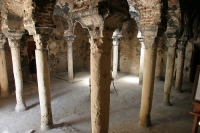
The only surviving Moorish building in Palma is the bathhouse of Banys Àrabs, located in the city's medieval quarter. It contains an elegant horseshoe-arched dome chamber supported by 12 columns, fronted by a lovely little garden with picnic tables. Although this is a small attraction, basically consisting of two empty chambers (hence the low admission cost), the old architecture is graceful and photographers should enjoy capturing the romantically dilapidated walls and columns. The baths are worth visiting to get some impression of the character of the old city as they are sadly all that remains. There is a short video show, in multiple languages, providing some historical information about the building, but not much else. The site is generally deserted and is a serene spot to imagine the past and take a break from sightseeing to read or write in the peaceful gardens. Bring your own picnic and enjoy a slow lunch at the baths. Although it is located on a small side road, the building is well sign-posted and shouldn't be hard to find. Those interested in history or Moorish architecture should not miss this tiny but charming attraction in Palma.
Address : Can Serra, Palma
Opening times : Open daily from 9.30am to 6pm
Admission : €2 (adults).

There are several good, though usually crowded, beaches accessible by bus from Palma. El Arenal, seven miles (11km) to the southeast of the city, attracts many German visitors to its waterfront restaurants, bars, and hotels. The long beach boasts white sands and turquoise water. Palma Nova and Illetes, six miles (10km) to the southwest, are smaller but equally popular and picturesque beaches. On the road to Palma Nova is Marineland, offering dolphin, sea lion, and parrot shows, as well as Polynesian pearl-diving demonstrations. Other beaches nearby include Portixol, El Molinar, Coll d'En Rebassa, and Can Pastilla. The most popular beach on the entire island of Mallorca, Es Trenc, on the southeast coast between Cap de Salinas and Cap Blanc, can be reached by bus from the Plaza Espanya in Palma. Es Trenc is a long narrow beach which is not affiliated to any resort and is therefore less commercial than many others on the island - although its popularity ensures it is still frequently crowded. It is a beautiful stretch of sand and an unofficial nudist beach.
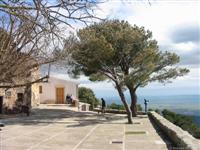
Mallorca's most popular hiking trail is the climb from the town of Alaro up to a ruined castle and hilltop chapel, which offers panoramic views of the sea and plains as far as Palma. From Alaro the walk takes about two hours to complete depending on fitness levels. A castle has stood on this site since Moorish times and the fortress was once so impregnable that the Moors managed to hold out against the Christian conquest for two years. Later, in 1285, Mallorcan independence fighters tried to defend the castle against Alfonso III of Aragon, but they were defeated and burned alive for their impudence.The castle ruins now visible on the hilltop date from the 15th century and dominate the landscape. They seem to grow out of the rock and are rather romantic and picturesque, fuelling the imagination. At the summit there is a restaurant and bar to refresh weary climbers. If you fall in love with the place it is possible to spend the night on the summit in one of the simple rooms. On Sundays the trail becomes rather busy. It is possible to drive almost all the way up if you don't mind dealing with rather scary, steep roads that aren't in the best state, but hiking is generally more satisfying.
Website : http://www.castellalaro.cat/en/home/
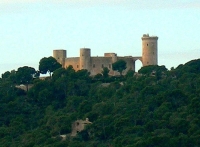
Built in the 14th century and surrounded by a double moat, this round hilltop castle was the summer residence of the kings of Mallorca. While once serving as a prison, it today contains Palma's Municipal Museum displaying archaeological artefacts and models of excavations. The unusual castle sits atop a lovely park area, highlights include spectacular views and photo opportunities. Visitors can explore a series of chambers upstairs above the museum below. Don't miss the prisoner's graffiti etched into the stonework, visible if you climb up to the roof. The Bellver Castle is on the route of the Palma City open-top sightseeing buses, but the walk up through the forest from Placa Gomilla is pleasant and not too strenuous, with many viewpoints to rest at along the way. Bellver Castle is one of the city's top attractions and a must-see for its vistas alone.
Address : Palma
Telephone : +34 971 730 657
Transport : Buses 3, 4, 20, 21 and 22
Opening times : Monday to Friday from 8am to 9pm, and Sundays from 10am to 7pm (April to June, September); Monday to Friday from 8am to 9pm, and Sundays from 10am to 2pm and 4pm to 8pm (July and August); Monday to Friday from 8am to 8pm, and Sundays from 10am to 5pm (October to March)
Admission : €4 (general), €2 (reduced) Monday to Saturday, free on Sundays.
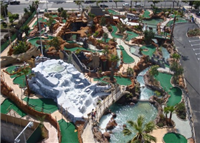
Katmandu Park is a theme park and mini-golf complex that proves wildly popular amongst younger visitors to Magaluf. Featuring cutting-edge technology, The House of Katmandu provides a thrilling and interactive haunted house experience for youngsters; The Asylum, aimed at older visitors (12 years and older), takes passengers on a scary journey through an abandoned mental asylum; the interactive motion ride Desperado is a comical cowboy gun slinging experience; and there is a 4D cinema to enjoy. The 36-hole (two 18-hole courses) Expedition Golf area of the theme park is hugely impressive, featuring fun and challenging courses, elaborately ornamented and themed, that even adults will find tough to master. There are a few food options when you get hungry, as well as a luxurious pool bar. Take kids of all ages to Katmandu Park for a day of fun and excitement they won't soon forget.
Address : Avenida Pedro Vaquer Ramis, next to the Hotel Magalluf Park.
Website : www.katmandupark.com/en
Telephone : +34 971 134 660
Opening times : Open daily 10am to 9pm (February, March, April), 10am to 10pm (May, September, October), 10am to 1am (June, July, August). Closed in November, December and January.
Admission : Cost of attractions vary, starting at about €20 for adults
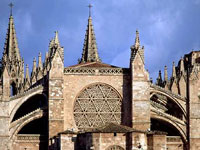
Palma's magnificent Catalonian Gothic cathedral is a landmark of the city, standing in the old town overlooking the ocean. The cathedral is actually called the Cathedral of the Saviour (Catedral del Salvador) but is situated on the Plaza de la Seo and is commonly referred to as La Seo. The cathedral forms part of a UNESCO World Heritage Site. The cathedral was built on the site of an existing ancient mosque and ancient Roman forum, and construction on the Romanesque Cathedral began in 1140. There have been numerous rebuilds, additions, and renovations since then, including an extensive restoration in the second half of the 20th century, when Roman and Muslim remnants were excavated and exposed. The cathedral has a rich and interesting history. From 1204 until the 15th century, all Aragonese kings were crowned in this church and it was the venue for royal baptisms, weddings, and burials. The head Inquisitor of Aragon, Pedro de Arbues, was assassinated in the cathedral while praying in 1485. He was later sainted and entombed in the cathedral.
Address : Placa Almoina, Palma
Telephone : +34 971 723 130
Opening times : Tuesday to Friday from 10am to 6pm, Saturday from 10am to 2pm. Open for services on Sundays
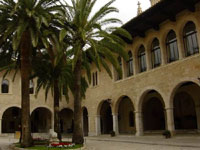
Opposite the cathedral in Palma stands an austere fortress palace that was erected by the Moors and later became the residence of the kings of Mallorca. The Moors built the fortress in 1281 and it was converted into a royal residence at the end of the 13th century, but evidence suggests that the Moors themselves built on an existing Roman fort. The palace is still officially a royal residence, although very seldom occupied, and is occasionally used for royal functions and events. Inside, most rooms and corridors are bare, but there are some beautiful Flemish Gobelin tapestries on display as well as a few antiques, art works and suits of armour. The royal apartments can be seen and there is an impressive Gothic chapel which showcases some rare late Romanesque architectural features. The palace, on the Plaza Reina, is surrounded by a pleasant Moorish-style garden sporting fountains, and offering panoramic views of the harbour. There is very little information in the fortress itself, but audio guides are available in English. Although visitors expecting lavish decor will be disappointed, exploring the palace is still fascinating and photographers will find plenty of worthy material.
Telephone : +34 971 214 134
Opening times : April to September open Tuesday to Sunday 10am to 8pm; October to March open Tuesday to Sunday 10am to 6pm; Closed Mondays.
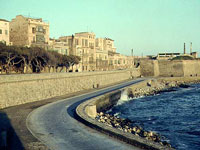
Palma is a lively cosmopolitan city, its centre forming a bustling maze of shopping centres, narrow lanes, and restored buildings surrounded by ruined ancient city walls and modern boulevards. The Moorish heritage of Mallorca is still evident, as are the remnants of Palma's golden years when it rose to wealth and prominence in the 15th century as the main port of call between Europe and Africa. Nowadays, it's a Spanish beach holiday haunt and favourite weekend city break destination of the rich and famous. Despite the invasion of foreign tourists, Palma has kept its local flavour, particularly in its old quarter, which is still lined by cafés and tapas bars. The biggest concentration of restaurants is in the centre of town, at El Terreno, and around the Paseo Maritimo. Palma de Mallorca's key activities centre on its nightlife and the town is well known for its bars and nightclubs. In fact, some of Spain's biggest nightclubs are in Palma de Mallorca and the city is a great destination for those seeking a party. Shoppers will particularly enjoy exploring the streets of the old town, while sightseeing attractions include the beautiful La Seo Cathedral, the fortress of Palau de l'Almudaina, the unusual Castell de Bellver, and some good museums. Unfortunately, the city doesn't have good beaches. Popular excursion destinations include the family-friendly Aqualand theme park, several excellent golf courses, and good hiking trails in the rocky Mallorcan hills.
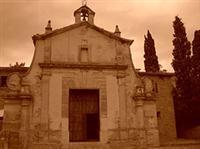
Situated in the hills towards the northeast of Mallorca, Pollensa is a peaceful old town that has been largely unaffected by tourism. It was established a few miles inland to protect against sudden pirate attacks. Today the port has grown into a popular family resort. Some of Pollensa's medieval centre remains around the Plaça Major, including the church of Nostra Senyora dels Àngels. The church is fairly austere, the sheer stone façade pierced only by a large rose window. But the interior is highly decorative. Other than the church, the main square houses a cluster of bars and cafés, and on Sunday mornings, a busy market. Just north of the square is the Via Crucis, a long stone stairway bordered by ancient cypress trees. At the top, in a small chapel, is a much-revered statue of Mare de Déu del Peu de la Creu. On Good Friday, a figure of Jesus is slowly carried down the steps by torchlight in the Davallament. Perched on a hill just south of Pollensa is a rambling 18th-century monastery, a peaceful and serene spot to take in wonderful views of the surrounding area. The monastery is an hour's walk from town.
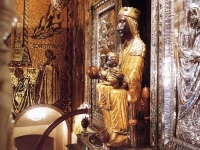
About 20 miles (32km) beyond Soller, after a drive through the Serra de Tramuntana in the north of the island, is the remote mountain village of Lluc, in a valley that has been an important place of pilgrimage since the 13th century. Lluc became Mallorca's most sacred site when a shepherd boy discovered a dark wooden statue of the Virgin in a cleft in the rock. The miraculous statue somehow returned to its cave three times after being placed in the local church. Now the statue, known as La Moreneta, has been encrusted with precious stones and resides in its own chapel, receiving pilgrims and tourists who come to pay homage each day. The main attraction of the town is the 13th-century Santuari de Lluc, the monastery which houses the statue, and remains a famous pilgrimage site. The sanctuary has a world-renowned boys' choir, established in 1531, which performs regularly. Although Lluc is primarily a special destination for the religious, it also has secular appeal, with some good restaurants and a scenic setting.
Website : www.lluc.net
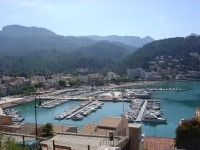
Soller is set in a lush valley of orange groves between the mountains and the sea halfway along the northwest coast of Mallorca. It's a popular daytrip destination because it can be reached on a vintage train ride from Palma. The train, a wood-panelled 1912 model, takes passengers winding through the beautiful craggy landscapes and into the Golden Valley where Soller is situated. The town is awash with tempting pastry shops, ice-cream parlours, and tapas bars in its quaint squares, but there is more to do than just eat and drink. There are some good examples of modernist architecture, like the church of Saint Bartomeu with its 1912 arched tower above a rose window and needle-like spires. There are also two museums: the Natural Science Museum and the Museu Municipal filled with antiques. There is a vintage tram running between the town and the port (Port de Soller). Soller is an ancient town, with evidence that the area was inhabited by humans as early as 5200 BC, but rather than big tourist attractions visitors will find buckets of charm and many good reasons to just relax and enjoy the atmosphere.
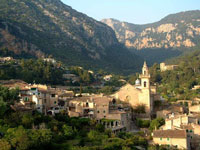
In 1838, Frederic Chopin arrived in the small town of Valldemossa with his lover, George Sand, to stay in a former monk's cell in the Cartoixa Reial monastery and carry on their affair away from the eyes of Paris. The shocked locals shunned the sickly Chopin and Sand, and the couple were so unhappy that their relationship never recovered from the wet, windy and miserable winter in the monastery. Today the cells occupied by the lovers are open to visitors. The library and old pharmacy can also be visited and there is a small art museum with works by Picasso, Miro, and Juli Ramis. Valldemossa is one of the prettiest villages in Mallorca: it is quiet and traditional, with narrow cobbled streets and a backdrop of forested hills. The 13th-century monastery is the most famous attraction of the town, but many hours can be spent happily wandering the streets and exploring the lush countryside. There are lovely cafes, restaurants, art galleries, and gift shops in Valldemossa. It is not a coastal town, but the port of the same name is very close and many beaches are within easy reach.
Website : www.valldemossa.es
Opening times : Cells open Monday to Saturday from 9.30am to 6pm, and on Sundays from 10am to 1pm

Travel Guide powered by Word Travels, copyright © 2023 Globe Media Ltd. By its very nature information in this travel guide is subject to change at short notice and travellers are urged to verify information on which they're relying with the relevant authorities. Neither Globe Media Ltd nor Travel Vogue can accept any responsibility for any loss or inconvenience to any person as a result of information contained above.